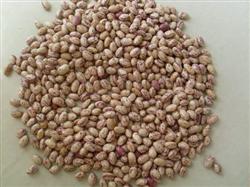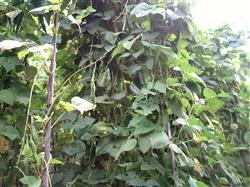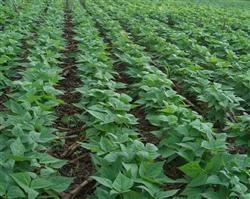High-yield cultivation techniques of flowered kidney bean

Core hints: main technical indicators: soil fertility index; fertilization index; density yield index; pesticide use restriction index. Flower kidney bean is the main cash crop in Altay region. Due to the high quality and unique light and heat soil and water resources in Altay region, the quality of flower kidney bean is excellent, with an average of 130,175 seeds per 100g, oval seeds, smooth skin, red and brown spots on milky white background, and excellent quality. It has been favored by foreign businessmen for many years, and it is also an important source of income for farmers and herdsmen in our region. The average output of 170kg in our region is 667m2. The highest 330kg, the general market price is about 3 yuan per kilogram. The main high-yield cultivation techniques of kidney bean in our region are summarized as follows. 1 main technical index 1.1 soil fertility index: soil mature layer > 30cm, total salt < 2g/kg, organic matter > 8g/kg, alkali hydrolyzable nitrogen > 30mg/kg, available phosphorus > 8mg/kg, available potassium > 120mg/kg, pH < 8 loam and sandy loam. Application of urea 15kg, diammonium phosphate 15kg, potassium sulfate 7kg, or basal application (also can be used as seed fertilizer) N16-P16-K8 15kg, topdressing of N20-P10-K10 15kg, foliar spraying molybdenum fertilizer or molybdenum micro-fertilizer. 1.3.The density yield index row spacing 50cm, generally not less than 16000 seeds per 667m2, 11 seeds per square meter, > 12800 seedlings per square meter, the number of harvested plants > 12000, the average harvest per square meter 8 million 10 plants, the average number of pods per plant 12 million 20, the number of seeds per plant 38 million 45 seeds per plant, 100 seed weight 55 million 71 g (that is, 140 seeds per hundred grams), the average yield of 250~300kg. 1.4 Pesticide use restriction indicators strictly prohibit the use of highly toxic, highly toxic and high residual pesticides. When diseases and insect pests occur in the field and reach the control target, drugs should be used in time according to the prevention and control methods of this procedure, alternately, and over concentration is strictly prohibited. If the occurrence of serious diseases and insect pests or the use of new pesticides, should be under the guidance of agricultural technicians, blindly mixed use of pesticides is strictly prohibited, private use of drugs is strictly prohibited. (2) the main measures before seedling are 2.1 Chemical fertilizer preparation to advocate heavy application of seed fertilizer, generally applying urea 5kg and diammonium 10kg per 667m2 respectively. Topdressing is generally applied with urea 10kg, diammonium 5kg and potassium sulfate 7kg per 667m2 respectively. 2.2 the land is prepared to select ripe land with deep and loose soil layer, low groundwater level and good drainage, and the previous crops are potato, wheat and corn (2349, 8.00,0.34%). It is not recommended to turn the soil in autumn, but mainly in spring. Before the suitable sowing date, if the soil moisture is insufficient, horse water should be irrigated. After spreading organic fertilizer, the soil moisture should be ploughed in time, and the depth of 20cm. After a short period of soil moisture dispersal, rake to preserve soil moisture (soil preparation with combined soil preparation machine is advocated), showing a state of waiting for sowing. 2.3 seed preparation kidney bean is a conventional variety, and the seeds with large, full, glossy, disease-free and pest-free seeds should be selected as seeds in order to improve the germination energy and the large-grain heredity of the variety. It is generally required that the weight of 100 grains is more than 57g, that is, the number of 100 grams is less than 175. Through the experiment, seed dressing with Likexiu can inhibit the growth of many kinds of miscellaneous bacteria. after seed dressing, although the emergence of seedlings is 1-2 days late, the growth potential is obviously enhanced and can stimulate growth and development. Each 100kg seed is mixed with 2% Likexiu active ingredient 2g 3G (such as 2% Likexiu seed mixing agent, 100g 150g), 100kg seed water 3kg, pour into the sprayer, then put in the seed mixing agent, stir well, spray the seeds, pile up for 3 hours and 4 hours, spread out to dry and sow the seeds. 2.4 timely sowing is 5-7 days before the local final frost, and sowing in time in accordance with soil moisture, generally from May 5 to 10 in Altay. Manual on demand is advocated in a small area, and air suction seeder is recommended in a large area, or a 24-line seeder is used to adjust it into 8 rows, with row spacing of 50cm. Artificial point sowing point distance 15cm, each hole 2-3 tablets, sowing deep 4~6cm, point covering soil and then gently step on and suppress. The air-suction on-demand machine sows deep 4~6cm, sowing 10 to 12 seeds per square meter, and the seeder is equipped with a ballast. Conventional sowing with 24-row seeder adjusted to 8 rows, sowing depth 5~7cm, sowing 11,13 seeds per square meter, with ballast behind the seeder. The lower mouth of the seeder is appropriately enlarged, the rotation speed of the metering cup is reduced, and the size of the metering cup is adjusted. 2.5.Formula for calculating the sowing rate: the sowing amount of 667m2 (kg) = the number of seeds / 100000 × 100g (g) of planned 667m2, and the sowing amount of 667m2 (kg) = the number of seeds / 10g / 100g of planned 667m2. 2.6. for artificial hole sowing with seed fertilizer, it shall be cut into a 10cm deep groove before sowing, and sown with seed fertilizer and covered with 2cm thick wet soil before planting; for air suction sowing, a special fertilizer applicator shall be used to apply seed fertilizer where the side of the seed is deeper than the seed 5~7cm. For conventional sowing, another 8 trench slices were adjusted, each of which depended on sowing trench film, and the distance between them was 6~8cm, and the pressure spring tension of sowing fertilizer trench film was adjusted to the maximum, and the tension of sowing trench film was adjusted appropriately, and then the sowing depth device was adjusted to make the sowing depth adjust to the right position. 2.7 advocate intercropping between flowered kidney bean and corn in order to improve the marginal effect and the ability to control diseases and insect pests. Generally, the bandwidth of flowered kidney bean is not lower than the height of intercropping corn. (3) the main measures after seedling inspection and replanting, light squatting seedling field seeds on a top soil, if there is a lack of seedlings above 20cm should be replanted immediately, soaked in warm water 3-4 days before replanting, seeds should be soaked and watered in time after seed whitening. Flowering kidney bean seedlings are generally not watered, but the implementation of light squatting seedlings, in order to promote plant roots deep, until the leaves show lack of water at noon before watering. 3.2Intermediate ploughing and topdressing is generally carried out from seedling emergence to the appearance of the first compound leaf, the depth of intertillage is 4~5cm, the second intertillage is carried out at the third and fourth compound leaves, the depth of intertillage is 8~10cm, and the third intertillage can be carried out at the same time as topdressing, seed fertilizer is applied to the lateral roots of the plant and ditches are deep 10~12cm. Artificial topdressing can implement nest topdressing, machinery can implement strip topdressing, generally combined with the third intertillage, the amount of topdressing is not less than 15kg per 667m2. Extra-root topdressing can be carried out at flowering and podding stage, foliar fertilizers such as amino acid leaf fertilizer, Aofeng, Lufeng 95 and Dafeiwang can be sprayed respectively, and aqueous solution such as urea or diammonium can also be sprayed with appropriate amount of ammonium molybdate. 3.3 Furrow irrigation is recommended for irrigation and weeding. The principle of irrigation is that there is no shortage of water, especially the first water. Once the seedlings show lack of water, they should be irrigated in time, and the first water should be fully irrigated, and ensure that the plants will not show drought after that. However, there can be no stagnant water in the field. If it is difficult to mature in the later stage, the water should be stopped as soon as possible, and if it can mature normally, the water should be properly controlled. Artificial weeding is the main method of weeding in small area. Attention should be paid to excessively dense seedlings when weeding, and mid-tillage is the main measure of weeding in large area. After irrigation, the growth of Monocotyledon weeds is accelerated, chemical weeding should be carried out, and 20% EC or 6.9% Weiba EC 400 times are commonly used to spray evenly, not less than 2 pots of Gongnong 16 type per 667 square meters, or ultra-low volume spray with motorized sprayers. 3.4 the control of diseases, pests and weeds can refer to the technical regulations for the prevention and control of diseases and insect pests of flowered kidney bean. The red spider is controlled in the spot film occurrence stage, and the special acaricidal agent is used to control it, generally 2 times and 3 times. Bacterial blight is the main disease endangering the production of kidney bean in our region. On the basis of strengthening field management, active prevention should be carried out at the seedling stage. Agricultural streptomycin can be sprayed at 5000 × 10 000 times or 77% can kill 500 times liquid or 1 ∶ 1 ∶ 200 Bordeaux solution. The incidence of Sclerotinia sclerotiorum can be reduced by properly controlling water and reducing field humidity in the middle and later stage of sclerotinia disease. At the initial stage of the disease, spraying 40% sclerotia net 600 times liquid or 12.5% quick protection agent wettable powder 3000 times liquid have better curative effect. Dicotyledonous weeds such as Chenopodium chinense occurred in the middle and later stage of the field, which should be removed as soon as possible in the field management. (4) timely harvest 4.1 indicates that most of the leaves in the field turn yellow, the stems and pods basically turn yellow or yellowish brown, the beans become hard and show the inherent color of milky white and brown, and the harvest can begin at this time. If the maturity in the field is poor, it should be harvested after the first frost in order to reduce the loss to a minimum. 4.2 the harvesting method is manually pulled up and piled into a small pile, mechanically pulled to the drying field, fully dried or dried and spread into a thickness of 1m, dragged or rolled by small four wheels and other machinery, and then become a commodity after manual clearing and lifting. Dry weather, low humidity in the field, should be pulled as early as possible, should also be transported back sooner or later, in order to reduce the loss; when the field soil is hard and not easy to pull up, irrigation can be done first, and then harvest.
- Prev

Three-dimensional cultivation of summer corn, autumn kidney bean and summer garlic seedlings
Autumn kidney bean is a temperature-loving vegetable, which is not resistant to high temperature and frost. It usually ends its growth before sowing frost in early autumn. The main supply season is in August and September, and the benefit is considerable. The main points of cultivation techniques are as follows: first, varieties selection of autumn kidney bean should choose varieties with heat resistance, disease resistance, strong adaptability and high pod setting rate, such as green dragon.
- Next

High-yield cultivation techniques of black kidney bean
Black kidney bean is commonly known as black adzuki bean, and has the effect of nutrition, nourishing immunity and so on. It is a black food with excellent medicine and food. The international market is in high demand. It is deeply welcomed by farmers because of its low input, high output, easy to plant and low risk. First, the characteristic growth period of the variety is 90 days, the accumulated temperature is 2000-2200 degrees, and the seed coat is black.
Related
- The first cup of black tea in spring, the flavor and history of tea gardens in Kenya, Africa
- The computer can not only choose potatoes, but also grow tea rice. AI will grow winter oolong tea champion.
- It is not only the inflated tea bitten by insects, but also engraved with the four seasons tea in Beipu.
- The Oriental Beauty Tea Festival in Zhuxian County takes the stage at the weekend to experience the plus-size feast of oil tea.
- & quot; Oriental Beauty Tea & Exploration of Emei in Hsinchu, the hometown of quot;
- The new variety of strawberry "Tainong 1" dessert is the first choice with mellow aroma. Crimson gorgeous
- History of Tea in Taiwan: from Wild Inner Mountain to Export Tea Garden
- Two types of Taiwan Oriental Beauty Black Tea won the British three-Star Award for Childhood Tea Xiang Zhang Jiaqi changed from pilot to champion tea maker.
- Banana species and varieties: the planting history of Taiwan Xianren banana and dwarf banana is long, is banana disease resistant?
- Coffee planting Technology: Qianjie Coffee from Seedling to harvesting

